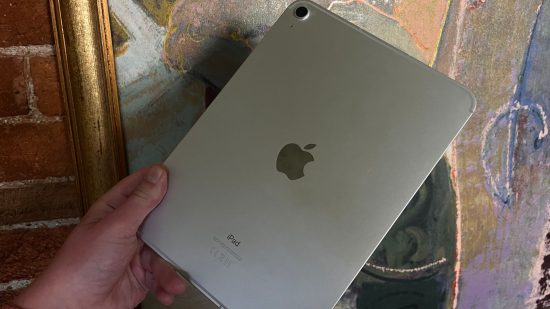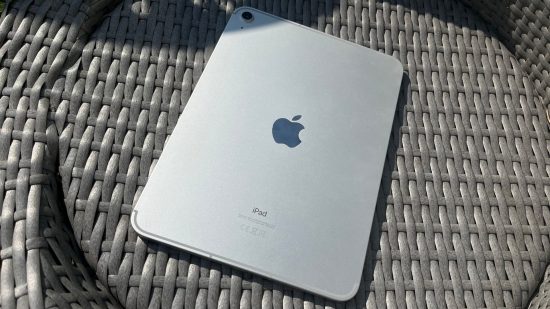Our Verdict
For all it's lovely design decisions, there are just as many baffling changes. It's by no means a bad piece of tech, but the tenth generation iPad feels like it no longer caters adequately to the budget tablet market. At least the ninth gen model is still available, eh?
Apple’s base model iPad has always been a big deal. Unlike the high-end phones that get all the press or the unholy speed of the new Macs, the iPad Pro has always felt like an indulgence. But the base model? Now that’s something fit for any home’s coffee table.
Whether it’s classrooms or living rooms, the base model iPad is a cheap, straightforward computing device chock-full of apps with a big screen to do stuff on. You could learn a language, draw a picture, or read a magazine. You can do this on any iPad – power doesn’t make a difference at this basic level of interaction.
And so we get to the tenth generation of Apple’s tablet which gets a redesign. Well, sort of. It looks exactly like the iPad Air. So, it’s a new design for the base model, but not really new by any other comparison.
Anyway, before we dive in deep, let’s do the equivalent of a tech journalist’s taxes and show you the specs.
| Apple iPad (10th gen) specs | |
| Display | 10.9-inch Liquid Retina IPS LCD (1640 x 2360) |
| Chipset | Apple A14 Bionic |
| Battery | Li-Po 7606 mAh |
| RAM | 4GB |
| Storage | 64GB/256GB |
| Price | from $449 (£499) |

Build
Now, the screen covers the whole front of the thing, there’s no home button, and the edges are flattened to fit in with the design language of every other Apple product you hold in your hand.
Apple has moved the camera, too, to the middle of the longer side, meaning you won’t be weirdly off-center during a landscape video call. There’s TouchID on the lock button, two volume buttons, and an update to USB-C too, meaning only the iPhone has to catch up to the rest of the tech world.
All these changes are good. Really good, in fact. It’s a treat to be able to use the same cable for your MacBook, Nintendo Switch, iPad, and pretty much every other device you own except an iPhone. The 1080p camera on the side is decent, and you’re framed neatly when using it. And removing the home button makes the whole thing look far prettier.
Prettiness brings the biggest benefit of all the changes. Apple’s build quality is always ace, and this feels like a lovely slab of metal. The front is clean, and while the bezels may look big, they’re actually pretty good considering the way you hold a tablet – half the time you need the bezel for thumb space.
So, the overhaul from the massive chin and forehead of the ninth generation is welcome. The whole lineup now matches (except the ninth gen, which Apple still sells, mind you), meaning you can set your iPhone down on the back of an iPad lay flat on a MacBook, and think, ‘nice’, if that sort of thing matters to you. But you won’t spend most of your time admiring the thing, you’re going to be looking at its screen, which is as meat and potatoes as it gets.
Display
The display does the job, as it were. It’s big, at 10.9 inches, which is lovely. Magazines are easily readable, photo-editing feels manageable, and videogames offer blockbustery scale that the standard-sized iPhone cannot. Basically, tablets are good, because bigger screens are nice.
Where you may think twice about this model is with the screen’s resolution. At 1640 x 2360, it has roughly 264 pixels per inch. The old model’s resolution is 1620 x 2160 pixels, which means it has roughly 265 pixels per inch. That’s one pixel more on the older model, sure, but the main thing to note is that the screen isn’t improved dramatically.
It is still improved, however. There’s less of a sunken gap between the glass front and what you’re looking at (this is rather noticeable on the ninth gen iPad). The colors also feel brighter, though according to the specs both this gen and the previous gen get 500 nits brightness so maybe my eyes are broken.
The best thing to note is that the screen works. It lets you look at things. And that’s good enough if all you want to do is look at things. Any photo editing whizz who needs something on the go ought to look elsewhere for clearer colors and a slicker refresh rate.

Performance
The new base model iPad features an A14 Bionic, unlike the previous gen’s A13. That’s the same difference between the iPhone 11 and iPhone 12 series of phones, a difference that is incremental. The ninth gen iPad is still excellently capable, the tenth gen just ever-so-slightly more.
But ignoring comparisons, performance during use is slick and excellent. Apple Arcade games fly along breezily, whether it’s the simple geometrics of Bridge Constructor or the vibrant and colorful Sayonara Wild Hearts. Genshin Impact runs beautifully too.
Meanwhile, music production apps like Garageband and Logic Pro barely hitch. You can load up a project with dozens of tracks and then plug in a ton of plug-ins and then maybe it starts to stutter, but anyone wanting to make a symphony on a tablet is likely already looking at the pro end. It’s good enough for what the average user needs.
It’s important to note that this iPad cannot run the new tablet version of Final Cut Pro. This app only works on iPads with an M1 or M2 chip inside. This is annoying, and it’s a little wild that a brand-new Apple app does not work on a tablet that came out a handful of months prior to the app’s launch.
Outside of that, however, you don’t really think twice about gaming performance while using the tenth gen iPad – a mightily impressive thing when it only has 4GB RAM, proving that Apple’s vertical integration leads to excellent gains throughout its products.
Battery
Every iPad offers around ten hours battery life. This is no different for the tenth gen base model. This ten hours is slightly modest, as I often find myself getting a good twelve hours use out of this model, though all this stuff depends on what you’re actually doing, of course.
Gaming sessions, music making, and other more taxing tasks bring it down quicker. Still, it’s good enough, and given that there’s not really Android competition in the tablet market, nor a better iPad model to get for battery life, if that’s your primary concern, you’re covered with this model.
Features
The biggest confusions around the tenth-generation iPad come when you think about the different features and accessory compatibility. While it’s a brand-new model in the lineup, it’s still held back by older accessories, which is really confusing.
Let’s say you’re an artist. You want a tablet to do some drawing on, but you don’t need a massive 13-inch behemoth. In general, performance isn’t a big deal if all you want is a digital canvas, so you consider going for the cheapest model, this model.
So, you’ve picked up a brand-new iPad. Now it’s time to get a stylus. Naturally, you expect to be able to get the latest Apple Pencil and snap it to the side of the tablet to charge it. Well, you can’t. In fact, you can’t use the latest Apple Pencil at all.
Instead, you have to get the first iteration of Apple Pencil. It’s a fine stylus, sure, but it charges via Lightning, not USB-C. So, if you want to charge your new-but-old Apple Pencil, you need an adapter. Because your new iPad only has USB-C. This is very, very silly.

Okay, let’s say you’re a student who doesn’t want to splash the cash on a MacBook. You just fancy using an Apple thing because everyone else in your lectures has MacBooks. You decide to buy the base model iPad, and like the idea of picking up the Magic Keyboard because it looks cool.
Well, you can’t use the Magic Keyboard. If you want it Apple-made, you can only use the new, tenth-gen-iPad-specific keyboard folio. This costs $249, only $50 less than that beautiful and exciting Magic Keyboard. Now, your iPad has cost you a minimum of $700. That’s almost a MacBook Air. And you can’t even transfer any ninth-gen iPad accessories over to this new iPad.
Lastly, let’s imagine you’re pretty much every person in the world and need more than 64GB of storage, the amount offered by the base model. Well, you can only upgrade to 256GB. This feels like a bit too much, but it’s best to have too much than too little, right? Well, now your iPad costs $599. And that starts to feel expensive.
So, you go back to the Apple site and look at all the iPad options. You can get the ninth gen iPad with 256GB of storage for $479. That’s only $30 more than its successor with 64GB. And what’s the big difference? Design? Well, how about functionality alone? It’s just that incremental shift from A13 to A14 Bionic, a landscape selfie cam, and that 0.7-inch screen size increase. And is that worth it?
Well, you see where I’m coming from. This iPad doesn’t really make sense. It’s a wonderful piece of kit, and reviewing devoid of any thoughts of price and it’s great. But if I had to tell my mother what iPad to buy, I couldn’t in good conscience say this one. It just doesn’t make sense.
If you’re looking for proof that I truly believe this, check out my guide to the best iPad 2023 – spoiler: the iPad Air is probably the best model to buy, though it’s a tough decision.


